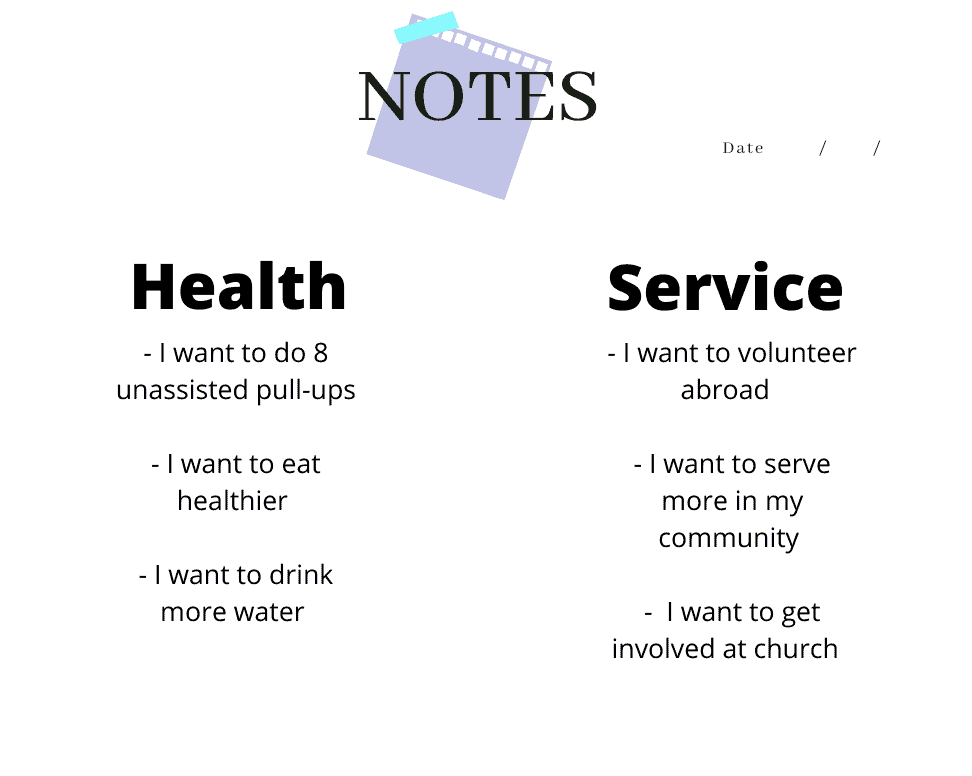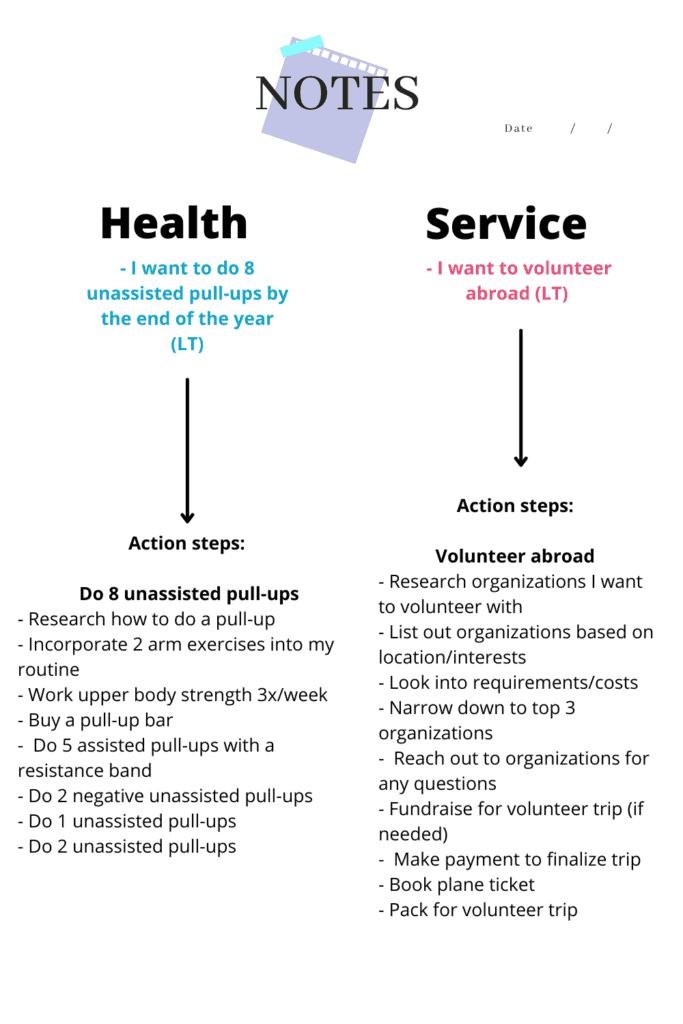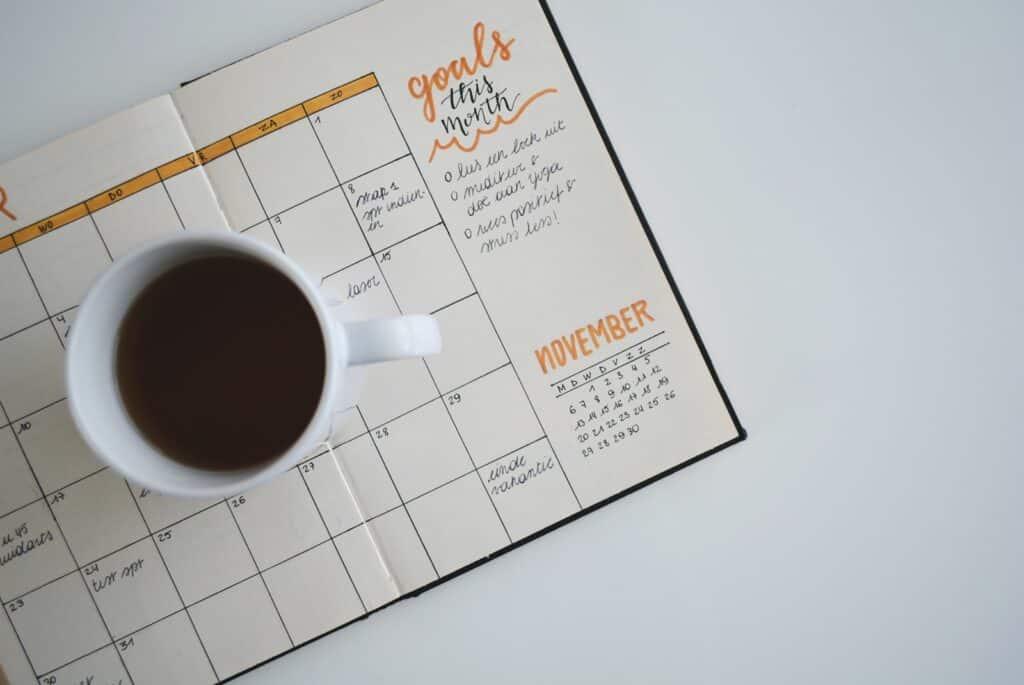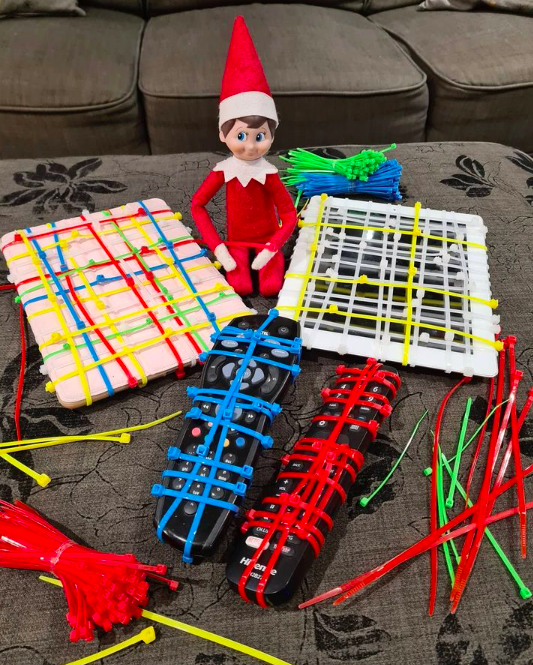How to Easily Break Down Your Goals Into Actionable Steps
Big goals can seem super overwhelming at first. Especially if you tend to see the big picture of a goal, it’s hard to take note of the next steps that follow it.
If you find yourself procrastinating on your goals, it’s probably because you’re struggling to break down your goals into actionable steps.
If you’re like me, I love visualizing and planning my goals but actually trying to achieve them?
Nah, that’s not my cup of tea (lol).
Growing up, I would get so excited to set my new year resolutions, plan my goals for the beginning of a new week/month, and create my bucket lists.
It was that dopamine rush that I would get from visualizing what it would look like to accomplish these goals. However, taking action was a different story. I would procrastinate on my goals and put them off until I forgot about them. Deep down, I was overwhelmed by how big my goals were that even thinking about starting them gave me anxiety.

Fast forward to today, I’ve learned how to set goals that are challenging, yet achievable. I’ve figured out how to break down my big goals into steps that don’t overwhelm and stress me out. To be honest, it’s the best feeling for me to not procrastinate anymore when it comes to goal setting.
In this post, I’ll share with you how to break down your goals into actionable steps. I’ll also provide goal setting and action step examples to give you a better idea of how my process works.
How to set a goal?
Before you first set a goal, ask yourself, “What do I want to achieve?”
When you do set a goal, it’s important to create a SMART goal (specific, measurable, attainable, relevant and time-bound). We’ll get into this more later on how to set SMART goals.
A goal can be a long-term or short-term goal.
A long-term goal may look like a 1 year, 3 year, or 5 year goal. An example of a long-term goal would look like: Earn a full-time income from my online business by 12/1/2024.
Ultimately, a long-term goal should be obtainable within a set number of years.
Here are 25 long term goal examples if you would like some inspiration!
On the other hand, short-term goals are goals you can set and start doing right now. An example of a short-term goal would look like:
Write 3 blog posts in March.

Why is goal planning important?
Goal setting is a powerful process that helps you to think about what you really want in life. It also motivates you to turn your vision of your future into reality.
Whether you’re setting a long-term or short-term goal, there are many benefits to goal planning.
It helps you stay focused and reflect on what areas in life you want to focus on.
If you have a goal without a plan, you’re setting yourself up for failure because there won’t be any action to follow-up.
If you actually set a deadline for your goals, you’re more likely to work towards achieving them and taking the necessary steps to do so.
A mindset trick: Put your goals somewhere you can visually see like hanging them up on your wall. They need to be goals you truly desire and are not based on other’s expectations of you.
What should be included in your goal planning process?
There are 8 different areas for goal setting:
- Health
- Relationships
- Money
- Career/Business
- Spirituality/Personal Development
- Environment/Organization
- Recreation/Fun
- Service/Contribution
If you would like some inspiration for goal setting in each of these life areas, check out this post to get more ideas!
For each of these areas, brain dump all the goals that you would like to achieve. No matter how small or big these goals are, don’t hold back. Just list out whatever comes to mind.
Tips to break down your goals into actionable steps
1. Decide on 2-3 areas you want to focus on
Once you’re done listing out all your goals for each category, take a look at your list and decide on 2-3 areas you want to focus on.
For example, you might decide to focus on the areas, health and service/contribution. If you want to focus on more areas, feel free to!
After you’ve decided to focus on these areas, get a sheet of paper or open an online document to take notes. Your next step is to write down the area of growth you want to focus on.
2. Write 1-3 goals for each area that you listed
Once you’ve decided and listed the area(s) you would like to focus on, write down your goals for each.
Here’s an example:

For example, let’s say under “health,” you decided to write down the goals:
- I want to do 8 unassisted pull-ups by the end of the year
- I want to eat healthier by eating out only 2-3x a week.
- I want to drink at least 8 cups of water for 3 months straight.
Notice how specific each goal is? That’s exactly what you want to do when creating goals. We want to set SMART goals – goals that are specific, measurable, attainable, relevant and time-bound. You want to make them challenging too, especially if it’s a long-term goal.
Personally, I’d recommend setting goals that are challenging, but realistic. For example, if the idea of doing 8 unassisted pull-ups by the end of the year makes you nervous, yet excites you, then that’s a good goal to set.
I encourage you to set goals out of your comfort zone. Here’s a great, short article that explains why it’s so important to set challenging goals. When you step out of your comfort zone, growth happens. So don’t be afraid to set challenging, big goals!
3. Brainstorm action steps for each goal
First, decide if your goals are long-term or short-term.
For example, let’s go back to the goal of doing 8 unassisted pull-ups. You might decide this is a long-term goal if you can barely do 1 assisted pull-up (I’m with you, friend).
Next to each goal, write “LT” for long-term or “ST” for short-term.
Here are the goals that I mentioned earlier, and this is what it would look like:
- I want to do 8 unassisted pull-ups by the end of the year (LT)
- I want to eat healthier by eating out only 2-3x a week (ST)
- I want to drink at least 8 cups of water for 3 months straight (ST)
Once you’ve categorized each goal based on LT or ST, now we can break down each goal into actionable steps.
Below, you can clearly see how I’ve broken down two main goals into action steps:

4. Write down your ‘WHY’ for each goal
Why do you want to achieve these goals?
Determining your big ‘why’ will keep you going when you want to give up or lose motivation along the way. Ultimately, your ‘why’ will propel you to keep moving forward, so make sure it’s a reason that resonates strongly with you.
Here are some examples:
- “I want to do 8 unassisted pull-ups because I want to be strong and be able to lift my own weight.”
- “I want to volunteer abroad in China, so that I can learn more about Chinese culture and help people who are in need of a helping hand.”
- “I want to learn Spanish because I want to be a bilingual speech-language pathologist and help Spanish-speaking families who need support.”
It might take some time to dig deeper into your ‘why.’
For example, your goal might be, “I want to eat healthier by eating out less.”
Why do I want to eat healthier? Because I want to live a healthier lifestyle.
Why do I want to live a healthier lifestyle? Because when I eat out a lot, I spend more than I need to, and I get more tired physically and mentally when I eat fast food a lot.
Your big ‘why’ could be:
I want to eat healthier, so that I can save money and feel better mentally.

5. Break down annual goals into monthly goals
Your annual goals will be long-term goals since they are more futuristic compared to monthly goals which are short-term goals. I’ll teach you how to break down your annual goals into monthly goals.
For example, if one of your annual goals is to volunteer abroad in China, then your monthly breakdown could look something like this:
- Month 1: Brainstorm causes I’m interested in
- Month 2-3: Find 3-5 organizations I want to volunteer with
- Month 4: Research costs and available dates I can go + book ticket
- Month 5: Start a fundraiser for volunteer organization (fundraiser goal: $)
- Month 6-7: Fundraise goal (ask, create gofundme, etc)
- Month 8-9: Prepare for trip
- Month 10-12+: Start volunteer program

6. Break down monthly goals in weekly goals
Now that we have a general overview of what each monthly goal looks like, we need to get a little more specific and set weekly goals. The more specific you are about your goals, the less likely you will procrastinate. So what does this look like?
Let’s go back to the example above. Since this example is more vague and flexible, there won’t need to be a goal for every week. If you want to volunteer abroad, here is an overlook of what your weekly goals could look like:
Month 1: Brainstorm causes I’m interested in
- Week 1-2: Write down what areas of service/causes I’m interested in serving in
- Week 3-4: Write down where I want to travel to
Month 2-3: Find 3-5 organizations I want to volunteer with
- Week 1-2: Create a document of all the organizations that interest me
- Week 3-4: Narrow down my list to 3-5 organizations
- (Keep narrowing down during month 3 to 1 organization)
Month 4: Research costs and available dates I can go + book ticket
- Week 1-2: Look up costs for organization and calculate total expenses
- Week 3-4: Book airplane ticket for volunteer trip
Month 5: Start a fundraiser for volunteer organization (fundraiser goal: $)
- Week 1: Brainstorm fundraiser ideas
- Week 2: Create fundraiser for volunteer trip
- Week 3-4: Continue to fundraise
Month 6-7: Fundraise goal (ask, create gofundme, etc)
- Week 1-4: Continue to fundraise to meet goal
Month 8-9: Prepare for trip
- Week 1-4: Create a packing list and start preparing for trip
Month 10-12+: Start volunteer program

7. Break down weekly goals into daily goals
Hopefully you have a better idea of how you can break down your monthly goals in weekly goals. I find that the more specific I can be setting goals, the more confident I feel. Let’s take it up another notch to breaking down weekly goals into daily goals.
I’ll use the example from above again. I’m going to break down the first month as an example because the other months don’t necessarily need a goal for every single day. To be honest, month 1 will not have daily goals, too, and you’ll see what I mean in a second.
As long as you have a weekly goal that gives you a general idea of what to accomplish that week, then you can still take action!
So let’s get into it!
Month 1: Brainstorm causes I’m interested in
- Week 1: Write down what areas of service/causes I’m interested in serving in
- Day 1: Ask myself, “What areas of service am I interested in?” (community service, missions, music, children’s ministry, home-building, etc) and braindump
- Day 3: Brainstorm volunteer goals – what I want to do and what I want to get out of it volunteering
- Day 5: Research other people’s experiences volunteering in the areas I’m interested in
- Week 2: Write down what areas of service/causes I’m interested in serving in
- Day 1-5: Narrow down areas of service/causes I’m interested in serving
- Week 3: Write down where I want to travel to
- Day 1: Brainstorm where I want to travel to
- Day 3-5: Research people’s experiences volunteering at this certain area
- Week 4: Write down where I want to travel to
- Day 1-3: Narrow down place I want to travel to
- Day 5: Write down things I should be aware of when traveling to the place (culture, language, etc)
Conclusion
And there you have it! This is my step-by-step method for breaking down any seemingly big goal into actionable steps. I know this was a lot, so to recap, here are the main points to remember:
- Decide on 2-3 life areas you want to focus on. (service/contribution, finance, health, etc.)
- Write 1-3 goals for each life area that you listed.
- Brainstorm action steps for each goal you listed.
- Write down your ‘WHY’ for each main goal. For example, if you listed 3 goals under ‘health,’ you want to write down your ‘why’ for each one.
- Break down annual goals into monthly goals.
- Break down monthly goals in weekly goals.
- Break down weekly goals into daily goals.
I hope this was helpful and gave you a better understanding of how to take a big goal and break into bite-sized, doable goals!
I’d love to know your thoughts about goal setting or if you have any method that helps you best. Comment down below!








One Comment
Comments are closed.